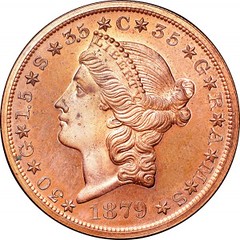
PREV ARTICLE
NEXT ARTICLE
FULL ISSUE
PREV FULL ISSUE
FORBES LIFE HIGHLIGHTS NEWMAN COLLECTION
Nick Graver forwarded this brief article from Forbes Life which profiles Eric Newman and his collection.
-Editor
Now those patterns are back in circulation–among collectors, anyway–having been sold in April by Heritage Auctions. Their value has skyrocketed: an 1879 “metric dollar” that Newman bought for $35 fetched $41,000; another from 1880, for which Newman paid $50, sold for $47,000. “Eric was way ahead of his time,” says Heritage cochairman Jim Halperin. “He’s a brilliant, brilliant man.” Yes, is brilliant: Newman, now 102 years old, not only had a great eye for valuable coins; he also played a major role in gathering the numismatic knowledge that got fellow collectors interested. “Fifty years ago, there were no databases,” Halperin explains. “You pretty much had to memorize things. Eric remembered.” On November 15 and 16, another portion of Newman’s vast holdings will go on the block at Heritage, with some of the most pristine early federal coinage among the 1,800 lots on offer. Highlights include a 1795 small eagle silver dollar valued at $650,000 and a 1796 quarter dollar valued at $800,000, both considered the finest such specimens in existence. The sale is expected to total more than $15 million. As with the patterns, these lots will surely go for orders of magnitude more than Newman paid. From his first purchase in 1921, when he was just 10 years old, Newman simply traded on what he knew. “My guess is that he made one of the greatest investments ever,” says Halperin. If only the architects of the euro had been so wise. Nick adds: The magazine has a huge super-detailed image of the 1796 bust half dollar. The layout is impressive, and then four other auctions are mentioned.
To read the complete article, see:
Never-Used Federal Coin Sale To Total Estimated $15 Million
(www.forbes.com/sites/jonathonkeats/2013/09/05/never-used-federal-coin-sale-to-total-estimated-15-million/)
The Numismatic Bibliomania Society is a non-profit organization promoting numismatic literature. See our web site at coinbooks.org. To submit items for publication in The E-Sylum, write to the Editor at this address: whomren@gmail.com To subscribe go to: https://my.binhost.com/lists/listinfo/esylum All Rights Reserved. NBS Home Page Contact the NBS webmaster 
|
